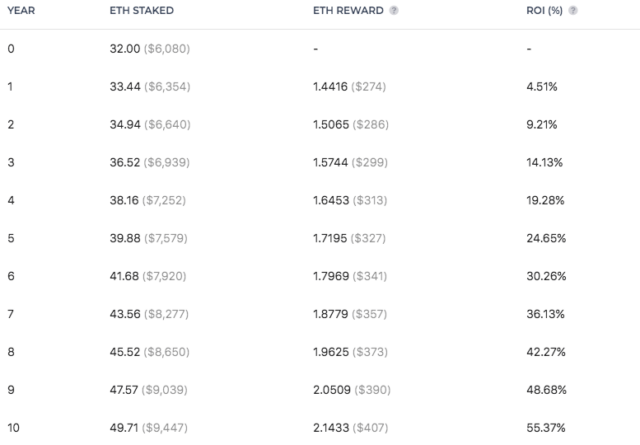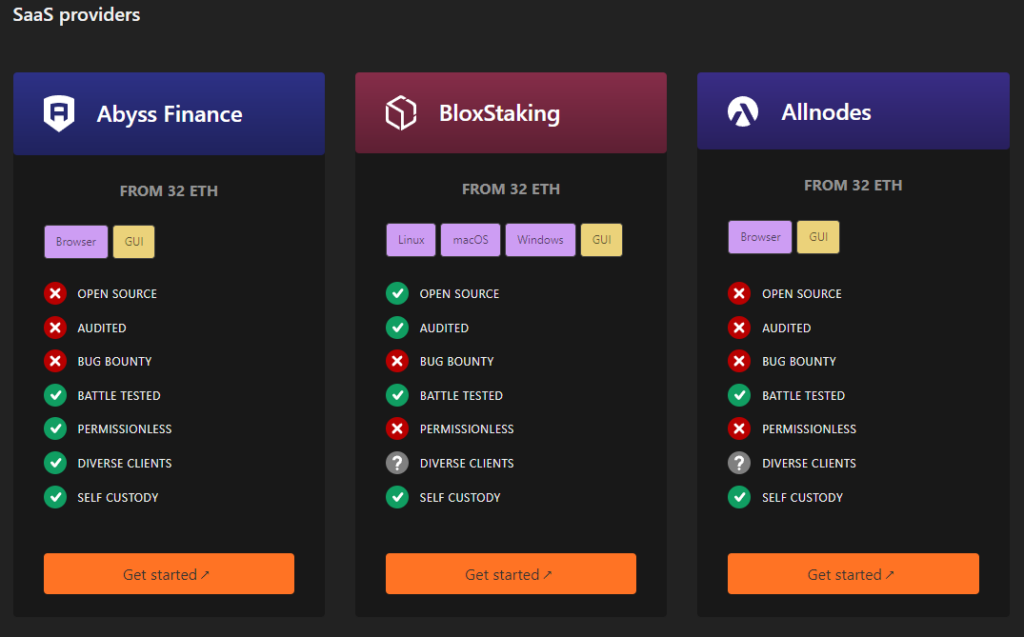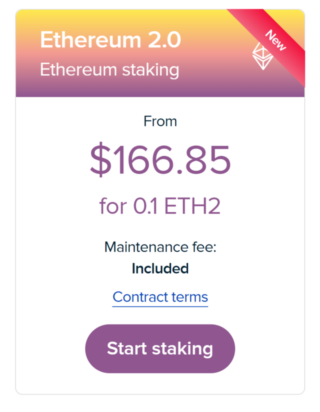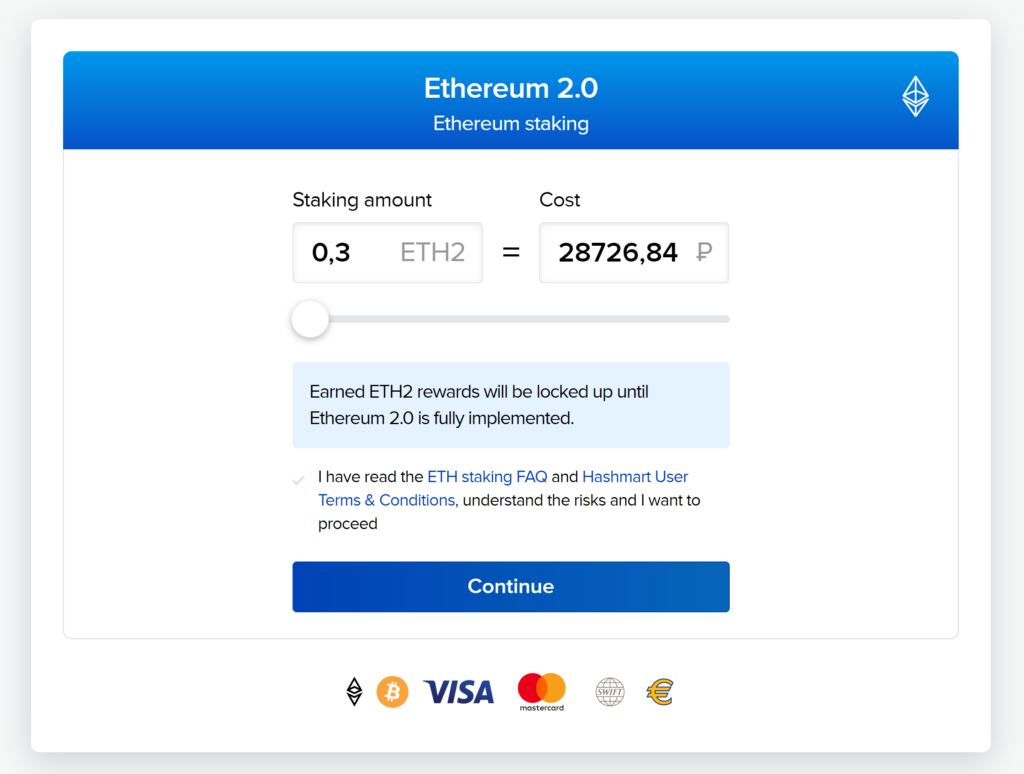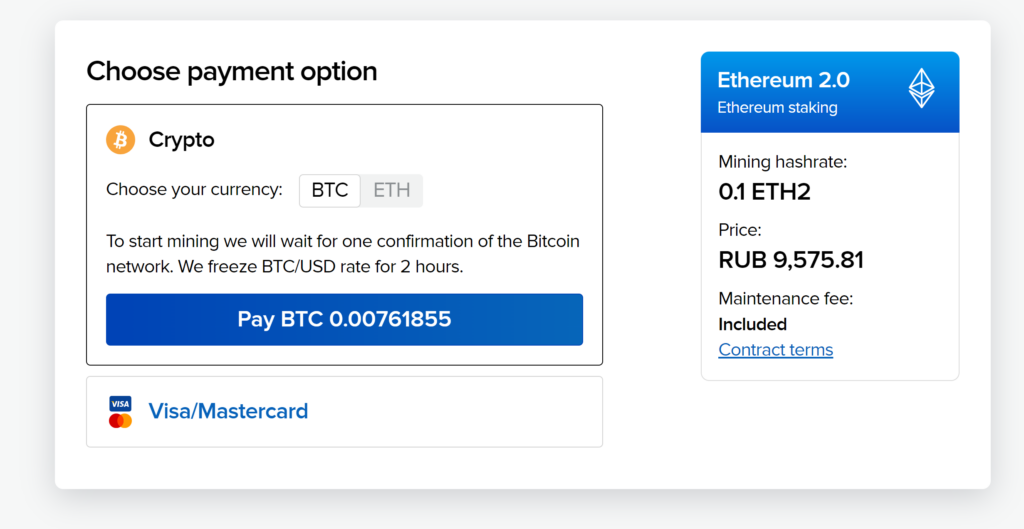All About Ethereum Staking at Hashmart

In the next few months, there will be an event many cryptocurrency fans have been waiting for several years. We are talking about the Ethereum transition, the second coin in terms of capitalization, to the Proof-of-Stake (PoS) algorithm. It is expected that the Ethereum network will consume much less electricity after the transition, and its throughput for transactions will increase hundreds of times.
An altcoin upgrade will completely change the model of earning on its issue. The role of miners will be taken by validators — those who invest a certain amount of ETH in a smart contract and will start making a profit from the moment they switch to PoS. You can get the role of a validator for yourself and lay the foundation for a future source of passive income right now. You can learn all the details in this article.
What is Proof-of-Stake?
As part of plans to provide a faster and greener transaction confirmation process, Ethereum developers have been working for several years to move from a consensus model known as Proof-of-Work (PoW) to Proof-of-Stake (PoS). The very term “consensus” in this context means a way to determine new blocks to add to the blockchain.
Proof-of-stake is the name of a consensus mechanism that requires users to deposit a certain amount of cryptocurrency to commit themselves to confirm transactions and, accordingly, to search for new blocks. So far, Ethereum is still working on PoW, where miners act as validators. Their “evidence” for finding new blocks is “work” – in the literal sense, the work of computing equipment (crypto farms). The proof of the validators is the number of cryptocurrencies they deposited in a smart contract. If the validator fails to fulfill his duties in good faith, his staking coins will be confiscated.
A validator in a PoS consensus mechanism increases its chances of earning rewards on the network by contributing more coins to a smart contract. To get the role of a validator, you need to deposit at least 32 ETH or $41,600 at the current cryptocurrency rate into the smart contract. For greater profitability, you need to deposit at least 64 ETH, 96 ETH, and so on. You can also participate in staking if you do not have the required amount – we will consider ways to earn money below.
Why is Ethereum moving to Proof-of-Stake?
One of the main reasons for changing the consensus mechanism is the subsequent sharp decrease in energy costs for confirming transactions and issuing ETH. According to the Ethereum Foundation, the development team expects Ethereum to consume 99.95 percent less electricity on PoS than it does now.
The thing is that the minimum hardware requirements for running a PoS validator node are much cheaper and more accessible to the average user than a profitable crypto farm for mining. Staking, unlike mining, can be carried out on ordinary computers or laptops, eliminating the need to use mining equipment that consumes a lot of electricity. And since staking is more accessible, it also means that more potential investors are likely to be interested in this business. This, in turn, will contribute to the even greater decentralization of the Ethereum network after its transition to Proof-of-Stake.
In addition, PoS will lay the foundation for “sharding,” a sharding technique that allows multiple parallel chains to share data and transaction load efficiently. These “sharded” chains, combined with a secondary scaling product known as “rollups,” could allow the project to process up to 100,000 transactions per second. For comparison, the Ethereum network currently processes up to about 15 transactions per second. “Rollups” involve combining dozens of transactions outside the main blockchain, creating cryptographic evidence for them (evidence of their validity), and then integrating them into the main blockchain.
How to invest ETH in staking?
Where to start cryptocurrency staking? There are three ways to make money staking, one of which can generate income even if your investment is well below the minimum requirement of 32 ETH.
Solo staking
Solo staking is the launch of a node on the Ethereum network connected to the Internet + depositing 32 ETH to get the role of a validator. With solo staking, the user is directly involved in confirming new transactions.
A network node consists of an Execution Layer (EL) client and a Consensus Layer (CL) client. These clients are software that, along with a valid set of signing keys, verifies transactions and blocks, validates the blockchain, combines transaction confirmations, and proposes blocks.
Solo Stakers are responsible for operating the equipment necessary for their work. It is strongly recommended to use a separate computer, which has fast Internet access and is well protected from malware. The solo staker is rewarded directly from the protocol for being a validator and being online.
Benefits of solo staking:
- Income in ETH without any intermediaries and commissions. Payouts are guaranteed as long as the altcoin network is working correctly (that is, the risks in this aspect are almost zero);
- Complete control over the process. The validator himself stores his keys and passwords and chooses a combination of clients and equipment that will allow him to optimize his activities as much as possible;
- A significant contribution to the overall safety of the project. The more solo stakers Ethereum has, the more reliable its network becomes.
Solo staking has its drawbacks, which can make this earning model unattractive for a significant number of crypto enthusiasts:
- Relatively high initial investment requirement of 32 ETH. This is almost 50,000 dollars; not everyone can afford it;
- The need to have basic knowledge of Ethereum clients, related software, and node maintenance. Note that to maximize profits, the validator node must operate 24/7;
- The inability to withdraw funds from the smart deposit contract. Until the Shanghai upgrade, which is planned after the transition to Proof-of-Stake, solo stakers will not be able to withdraw their ETH.
In general, solo staking is suitable for already quite experienced investors who have the necessary number of coins and are ready to invest them in a smart contract for a long time to receive a relatively low but guaranteed income with the most minimal risks. The staking calculator from the Staking Rewards platform will help you calculate approximate profit.
Staking-as-a-service (SaaS)
Staking-as-a-service (SaaS) is the general term for the range of services provided by centralized platforms. Their clients pay the required minimum deposit of 32 ETH (or multiples of it), and the platform performs all technical operators with a validator node for a fee. Then upload your signing keys to the operator. This allows the service to manage your validator on your behalf at the rate set by the platform.
Benefits of Staking-as-a-service:
- An investor does not need to understand the technical intricacies of staking, setting up equipment, and so on;
- At the same time, the one still contributes to the smart contract and gets the role of a validator;
- Limitation of risks when working with an intermediary. Two types of keys are generated for the SAAS user: those with which you can withdraw funds from the smart contract and those with which transactions are confirmed. The SaaS platform receives the second type of keys from its client, so its ETH is safe even from an attempted theft by the platform itself.
Since the client’s deposit remains on the same terms as solo stakers, one will also be able to withdraw coins only after the upcoming Shanghai upgrade. On the positive side, the client of the SaaS platform does not need to worry about setting up equipment or anything else until the final transition to Proof-of-Stake.
Conclusion: This type of earnings on staking is suitable for those with significant capital for investment but with limited time and resources to set up a network node. True, the profitability will be less than solo staking since part of the funds will be spent on paying for SaaS platform tariffs, and you will also have to buy Ethereum.
Pool staking
Staking pools are platforms that allow their clients to earn staking returns even with an investment substantially less than the minimum required 32 ETH. Ethereum developers do not provide staking pools, so third-party centralized resources implement this concept.
Some pools use smart contracts to keep track of customer deposited funds and even lend them in the form of alternative tokens with the same value. Other pools may not use smart contracts and operate entirely off the Ethereum blockchain. Note that different teams have developed each pool, its tools, or smart contracts, and each of them has its risks and benefits.
Here are the main advantages of pool staking as a concept:
- Low entry threshold. Some platforms offer the opportunity to invest in staking from 0.01 ETH. Even a novice in the industry can afford the investment;
- The ability to use equivalent pool tokens as collateral for staking in decentralized applications. That is, ETH does not just remain in the smart contract until the withdrawal, but their value can still be used to generate additional profit;
- Staking in a pool is as simple as an instant token swap – no need to worry about setting up equipment and maintaining a network node. Pools allow you to deposit your ETH and distribute the rewards evenly among their clients.
Individual platforms and large centralized exchanges can offer staking services for Ethereum. The difference between them lies in terms of service and commissions, so here customers should focus on their individual preferences.
Staking at Hashmart
Choosing the right staking platform can take a very long time, but if you are reading this article, you already have a great candidate – Hashmart.io! You can participate in Ethereum staking with a minimum deposit of only 0.1 ETH. By working with our service, you can get almost the same profitability as a solo staker, but at a much lower cost and without the need to maintain equipment.
Our clients can invest in the pool using several payment methods at once. Transactions in BTC and ETH are available, as well as the ability to pay for an investment with a Mastercard or Visa card. According to the terms of the tariff, the commission is included in its cost, so after the initial transaction, you just have to wait for Ethereum to switch to Proof-of-Stake.
Recall that the transition should take place in November; this information appeared after a recent online conference of altcoin developers. Given that the crypto investor community has been preparing for the transition event for several years now, news of the imminent transition will most likely lead to an increase in the value of Ethereum. With Hashmart, you can start staking Ethereum for profit and become a validator, earning extra on the bull run if the Ethereum growth forecast is correct. Start investing in the future of the crypto market with Hashmart right now!


